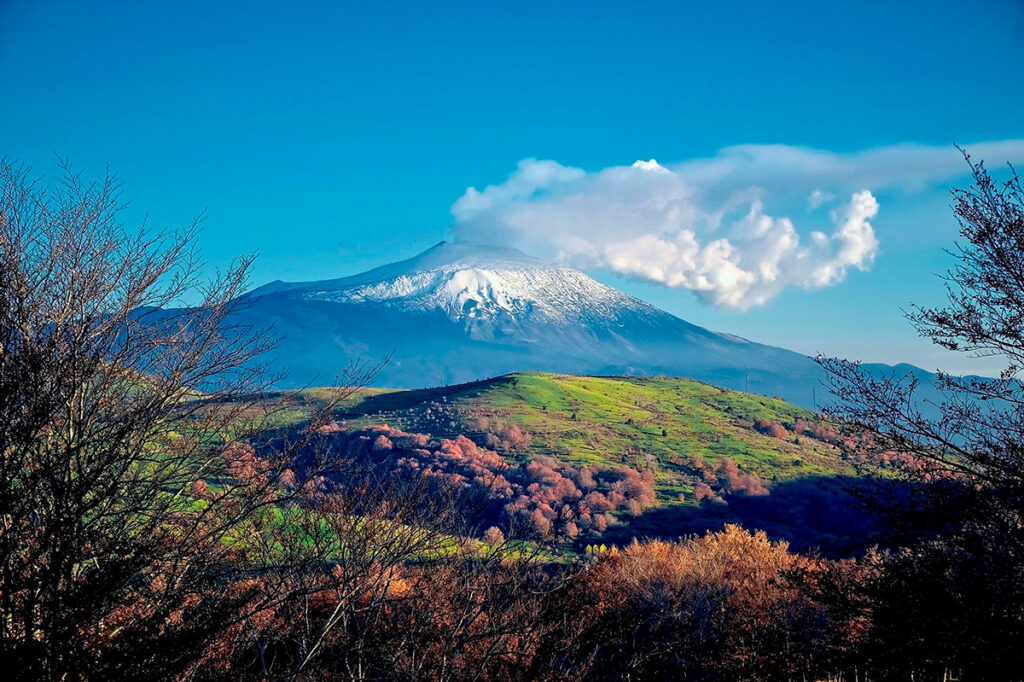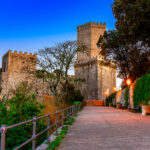We leave for an excursion to the highest active volcano in Europe and its natural park, where opposites come together to create places of incomparable beauty
Fire and ice, destruction and life, ash and vegetation… Opposites attract, mix, and unite to create a constantly changing environment that hosts life where everything seems inhospitable. The Etna Park is a place full of charm and mystery, where nature generates as much fear and respect as it does amazement and wonder.
Created by decree of the President of the Region on 17 March 1987, the Etna Park was the first natural park to be established in Sicily. An obligatory choice to defend nature which had been under assault since the 60s, when the spread of personal means of transport had seen an important increase in tourism above “a Muntagna” (as Etna is called by the inhabitants of neighboring towns).
The natural park includes Mount Etna, the highest active volcano in Europe with its 3,357 meters above sea level, and everything found on its slopes, for a total of 59 thousand hectares of surface area where twenty municipalities fall: Adrano, Belpasso, Biancavilla, Bronte, Castiglione di Sicilia, Giarre, Linguaglossa, Maletto, Mascali, Milo, Nicolosi, Pedara, Piedimonte Etneo, Ragalna, Randazzo, Santa Maria di Licodia, Sant’Alfio, Trecastagni, Viagrande and Zafferana Etnea.
The park is divided into four zones based to the levels of protection. In Zone A, which starts from the summit craters and is the highest of the four, nature must be preserved in its integrity, limiting human intervention to the bare minimum. It is the area of lava deserts and large uncontaminated spaces, where life forms find prohibitive conditions. But it is also the house to large birds of prey such as the golden eagle. In the lower altitudes you can find the first plants up to some forest formations, even extended, with beeches, birches, pines, downy oaks and holm oaks.
Zone B, which ranges from a maximum of 1880 meters in height to a minimum of 640 meters, is an area where protection is combined with the economic development of traditional activities such as agriculture. Vineyards, apple orchards and pear groves have been created on terraces on the sides of the volcano. In addition to the wines, which benefit from the soils and microclimate for a production with a unique flavor, the Bronte pistachios and Sant’Alfio hazelnuts are also famous. In this area there are lava formations where pioneer species and endemic plants such as the Etna broom are found.
Zones C and D are called “protected and controlled development” and are part of the pre-park. Economic and commercial activities can be created here, but they must always be compatible with respect for the environment and the landscape, as well as having as their objective the enhancement of the park itself. In addition to tourist and sports facilities, cultivations continue, such as those of olives and almonds.

Inside the Etna Park it is possible to find a varied fauna, such as the wild cat, the Etna fox, the porcupine, the rabbit, the hare, the weasel, the hedgehog, the dormouse and other small rodents. Many species of birds also nest, especially birds of prey: in addition to the aforementioned golden eagle, there are the sparrowhawk, the peregrine falcon, the kestrel, the buzzard, the barn owl, the owl, the scops owl and many others.
There are numerous paths for those who love hiking, as are also the refuges where you can stop to rest or spend the night. Excursions in the park are among the major tourist attractions in the area and lead to discovering a world of magnificent scenery and unique biodiversity.
Speaking of unique places to visit, Etna is home to the Grotta del Gelo. Located on the northern slope of the volcano, due to the presence of perennial ice inside the cave, it is considered the southernmost glacier in Europe and the entire northern hemisphere. It is located at 2030 meters above sea level and is a sliding tunnel about 125 meters long generated by a lava flow due to the eruption which occurred in July 1614.
Also of great geological interest is the Valle del Bove, which is located on the eastern side of the volcano. It is a basin with a perimeter of over 20 kilometers which is thought to have been created by the sinking of two volcanic buildings (the Trifoglietto I and Trifoglietto II) precedings Etna, which occurred 64 thousand years ago.
Etna entered the list of UNESCO World Heritage Sites in 2013. A recognition that confirms the importance of the Etna Park from a geological, historical and tourist point of view. You really can’t miss the opportunity to go on an excursion on the “Muntagna”, among ice, fire and so much wonder.





Comments are closed.